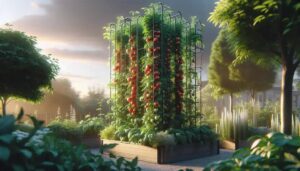Vertical trellis gardening optimizes space by supporting climbing plants like beans, improving air circulation, reducing diseases, and increasing yields, making it ideal for small or urban gardens.
Have you ever thought about how **beans** can thrive on a vertical trellis? This setup not only maximizes space but also simplifies your gardening efforts. Let’s dive into how this works!
how vertical trellis works for climbing beans
Using a vertical trellis for climbing beans is a game changer for gardeners looking to maximize space. Beans naturally climb, and a vertical structure mimics their natural growth habit, leading to healthier plants.
The trellis offers beans the support they need to grow upwards, making harvesting easier and reducing pest problems. These structures are particularly useful in small gardens, allowing beans to thrive without spreading horizontally.
Construction of a vertical trellis involves simple materials like bamboo stakes or metal poles. Spacing the poles appropriately and securing them with durable wire or twine ensures stability, even as the beans become heavier.
Key Features of Vertical Trellises
Vertical trellises improve air circulation around bean plants, reducing humidity-related diseases. Plants grown vertically receive more sunlight, promoting stronger, healthier growth and better yields.
By mimicking a natural climbing environment, trellises also encourage deeper root systems. This results in more resilient plants capable of withstanding varied weather conditions.
benefits of using trellis in home gardening
Incorporating a trellis into your home garden can significantly transform plant growth and yield. A trellis provides crucial support for climbing plants, allowing them to grow vertically rather than spreading on the ground. This method enhances space efficiency, making it ideal for small gardens or urban spaces.
Beyond space saving, trellises improve air circulation around plants. This leads to healthier growth by reducing the risk of fungal diseases often caused by damp conditions under dense foliage. Light penetration is also maximized, ensuring all parts of the plants receive adequate sunlight for photosynthesis.
Gardening with trellises can mean easier access for maintenance and harvest. When plants grow upwards, it’s simpler to prune, fertilize, and harvest without crouching or straining. This vertical approach can also beautify a garden with lush green walls that add height and interest to your landscape design.
Enhanced Plant Health and Productivity
The use of trellises can facilitate the growth of stronger root systems, as plants focus their energy on vertical development. This results in hardier plants capable of producing more fruit or flowers. Additionally, minimizing soil contact helps in reducing pest infestations, safeguarding your crops from common threats.
step-by-step guide to setting up a trellis
Setting up a trellis for your garden can seem daunting, but following a step-by-step approach simplifies the process. First, select a suitable location that receives ample sunlight and has sturdy soil. It is crucial to anchor the trellis firmly, ensuring it can support the weight of mature plants.
Begin by gathering materials: strong posts, netting or wires, and sturdy ties. Position the posts in the ground, making sure they are deep enough to remain stable. Use a mallet for extra security. Next, attach the netting or wire between the posts, ensuring it is taut and supportive.
Assembling the Trellis Structure
When assembling, adjust the spacing of the netting according to the types of plants you are supporting. Beans, for instance, require close-meshed support to climb efficiently. Secure the trellis with ties or clamps to keep it balanced. Remember to leave enough room for plant maintenance as they grow.
Continuously check the stability of the setup, especially during windy conditions. Monitor plant progress and adjust ties as necessary to guide them along the trellis.
A well-constructed trellis not only enhances the health and productivity of your plants but also adds an elegant visual element to your garden.
choosing the best types of beans for trellising
Choosing the best types of beans for trellising can greatly impact your garden’s productivity. Climbing beans, or pole beans, are ideal for vertical growth. They grow tall and produce abundantly when guided on a trellis.
When selecting bean varieties, consider those with vigorous vining habits. Popular choices include Kentucky Wonder and Blue Lake, known for their heavy yields and resilience. These beans thrive on a sturdy trellis and require minimal maintenance.
Key Considerations
Evaluate your climate and soil conditions, as some bean varieties are better suited to specific environments. Scarlet Runner beans, for instance, flourish in cooler climates, offering vibrancy to your garden with their colorful blooms.
Purchasing certified seeds ensures you start with quality. Look for disease-resistant varieties to prevent common bean diseases like rust or mosaic virus. This ensures a healthier crop throughout the season.
By choosing the right beans for trellising, you optimize your vertical garden space and enjoy a bountiful harvest.
common mistakes to avoid with vertical gardening
When practicing vertical gardening, avoiding common mistakes can ensure success. One frequent error is overcrowding. Planting too many seeds too close can limit growth and reduce air flow, encouraging pests and diseases.
It’s crucial to choose the right plants for trellising. Not all varieties thrive vertically, so research beforehand. Ensure that your trellis is sturdy and well-anchored to prevent collapse under plant weight or severe weather. Properly secured structures are essential for supporting climbing plants.
Over or under-watering is another pitfall. Vertical gardens may dry out faster due to increased exposure. It’s important to maintain a consistent watering schedule, checking soil moisture regularly.
Key Tips for Success
Pruning is often overlooked. Regularly trim plants to direct energy towards producing fruit or flowers. This not only keeps plants healthy but also makes the most of your vertical space.
Avoid the mistake of ignoring maintenance. Fertilize appropriately to provide adequate nutrients for optimal growth. With attention to these factors, your vertical garden can thrive beautifully.
success stories from experienced gardeners
Hearing success stories from experienced gardeners can be inspiring. One gardener transformed a small urban backyard using vertical gardening techniques. They used trellises to support a variety of climbing plants like beans and peas, maximizing space and yield.
Another gardener shares their experience with growing tomatoes vertically. By using sturdy stakes and careful pruning, they achieved a bountiful harvest even in a limited space. The trellis kept the plants upright, reducing diseases common in ground-spreading varieties.
Community Gardening Projects
A community gardening group implemented vertical gardening in a shared space, allowing more people to participate. Using recycled materials for trellises, they grew a diverse set of crops including cucumbers and squash. This method engaged the community and provided fresh produce for local families.
These stories show that with creativity and innovation, even small gardening spaces can become productive and beautiful. Learning from the experiences of others can guide novice gardeners in achieving their own successes.
The wrap-up on beans and vertical gardening
Embracing the use of vertical trellises in your garden transforms even the smallest spaces into vibrant, productive areas. With careful selection of climbing beans and awareness of common mistakes, your garden space can flourish.
The step-by-step guide aids in constructing sturdy structures, while avoiding pitfalls ensures longevity and health for your plants. Learning from success stories of experienced gardeners can inspire creativity and innovation in your own projects.
Whether you’re adding height to your garden or increasing yield, vertical gardening with trellises opens a new realm of possibilities. Start small, learn as you go, and enjoy the many benefits this method brings.
FAQ – Frequently Asked Questions about Vertical Gardening with Trellises
What are the main benefits of using a trellis in my garden?
A trellis supports plant growth vertically, maximizing space, improving air circulation, and reducing disease and pest problems.
Which types of beans are ideal for growing on a trellis?
Pole beans like Kentucky Wonder and Scarlet Runner are great choices due to their vigorous climbing habits and high yields.
How should I start setting up a trellis at home?
Begin by choosing a sunny location, gather materials like sturdy posts and wire, and ensure the structure is well-anchored for stability.
What common mistakes should I avoid with vertical gardening?
Avoid overcrowding plants, ensure proper watering, choose suitable plant varieties, and regularly maintain the trellis for best results.
Can vertical gardening be practiced in small urban spaces?
Yes, vertical gardening is perfect for urban areas as it utilizes vertical space efficiently, making it suitable even for small balconies and backyards.
How have experienced gardeners benefited from vertical gardening?
Experienced gardeners have seen increased yields, improved plant health, and more engaging community gardening projects through vertical gardening.



